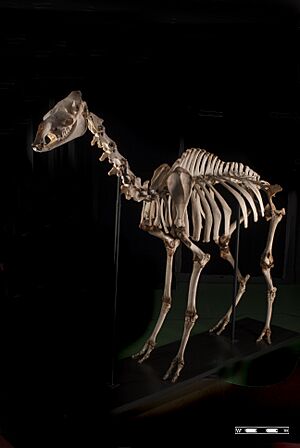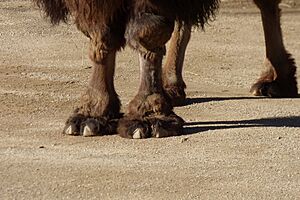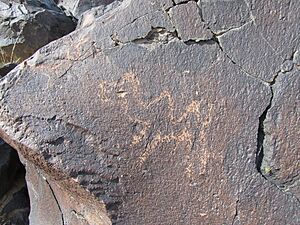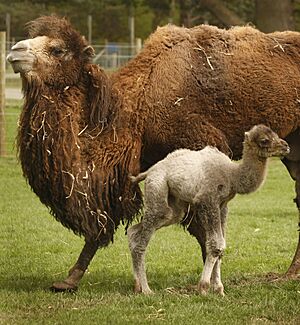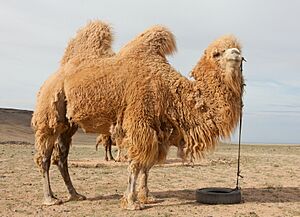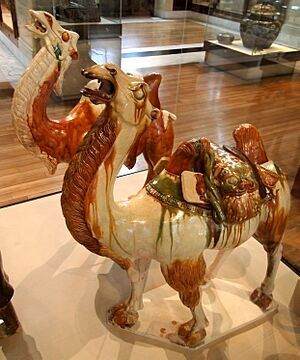Bactrian camel facts for kids
Quick facts for kids Bactrian camel |
|
|---|---|
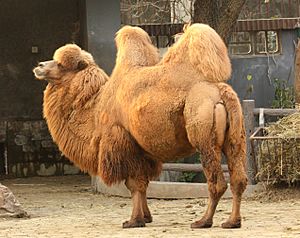 |
|
| A Bactrian camel in the Shanghai Zoo | |
| Conservation status | |
| Scientific classification | |
| Kingdom: | |
| Phylum: | |
| Class: | |
| Order: | |
| Family: | |
| Genus: | |
| Species: |
C. bactrianus
|
| Binomial name | |
| Camelus bactrianus Linnaeus, 1758
|
|
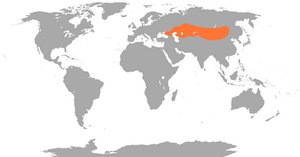 |
|
| Geographic range | |
The Bactrian camel (Camelus bactrianus), also called the Mongolian camel, is a large, hoofed animal with two humps. It comes from the steppes of Central Asia. Unlike the dromedary camel which has one hump, the Bactrian camel has two.
There are about two million Bactrian camels in the world today. Most of them are tamed by humans. Their name comes from an old region called Bactria.
For a long time, domesticated Bactrian camels have been used as pack animals in Asia. This means they carry goods for people. They are very good at living in cold, dry places and high mountains. Because of this, they helped people travel along the famous Silk Road, carrying goods in groups called caravans.
It's important to know that domesticated Bactrian camels are a different species from the wild Bactrian camel. The wild Bactrian camel is the only truly wild camel species left in the world.
| Top - 0-9 A B C D E F G H I J K L M N O P Q R S T U V W X Y Z |
What is a Bactrian Camel?
The Bactrian camel belongs to the same animal group, or genus, called Camelus as the dromedary (C. dromedarius) and the wild Bactrian camel (C. ferus). All these camels are part of the Camelidae family.
An ancient Greek thinker named Aristotle was the first to describe different camel species. In his book from the 4th century BC, he talked about the one-humped Arabian camel and the two-humped Bactrian camel. Later, in 1758, a Swedish zoologist named Carl Linnaeus gave the Bactrian camel its scientific name, Camelus bactrianus.
Physical Features of the Bactrian Camel
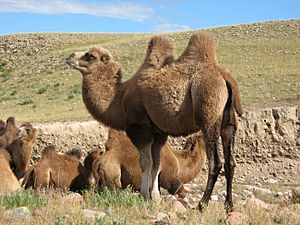
The Bactrian camel is the biggest mammal in its natural home. It is also the largest living camel.
These camels can stand from 180 to 230 centimeters (about 6 to 7.5 feet) tall at the shoulder. Their body length is about 225 to 350 cm (7.4 to 11.5 ft), and their tail is 35 to 55 cm (14 to 22 inches) long.
They have a long, woolly coat that can be dark brown to sandy beige. They also have a long mane and beard on their neck and throat. These hairs can be up to 25 cm (10 inches) long.
In winter, their shaggy coat keeps them warm. But when spring comes, they shed their fur very quickly. Large pieces of their coat peel off all at once.
The two humps on their back are made of fat, not water, as some people think. This fat helps them survive when food is scarce.
Their face is long and somewhat triangular, with a split upper lip. They have long eyelashes and nostrils that can close. These features help keep out dust during the frequent sandstorms in their natural habitat.
Each foot has two wide toes with tough, undivided soles. These toes can spread out, which helps them walk easily on sand. Their feet are very strong, perfect for living in harsh environments.
Where Bactrian Camels Live
Bactrian camels are migratory animals, meaning they move from place to place. Their homes can be rocky mountains, flat dry deserts, stony plains, or sand dunes.
The conditions in these places are very tough. There isn't much plant life, water is hard to find, and temperatures are extreme. It can get as cold as -40 degrees Celsius (-40°F) in winter and as hot as 40 degrees Celsius (104°F) in summer.
Where camels live depends on where they can find water. Large groups gather near rivers after it rains. In summer, they find water from springs at the bottom of mountains. In winter, they can get water from snow.
Life of a Bactrian Camel
Bactrian camels are very good at handling big changes in temperature, from freezing cold to scorching heat.
They can go without water for months. But when they find water, they can drink a lot, up to 57 liters (15 gallons) at once!
When they eat well, their humps are full and stand up straight. But if they don't get enough food, their humps shrink and may lean to the side.
When they move faster than a walk, they pace. This means they move both legs on the same side forward at the same time. Most other four-legged animals trot, using opposite legs. Bactrian camels can run up to 65 kilometers per hour (40 mph), but they rarely go that fast.
Bactrian camels are also known to be good swimmers. They have excellent eyesight and a very strong sense of smell.
Bactrian camels can live up to 50 years. In zoos or other controlled environments, they often live for 20 to 40 years.
What They Eat
Bactrian camels are active during the day and sleep outside at night. They mostly eat plants.
They have tough mouths that can handle sharp things like thorns. This allows them to eat dry, prickly, salty, or bitter plants. They can eat almost any kind of plant. If there isn't enough plant food, they might eat animal remains like bones, skin, or meat.
In very difficult conditions, they might eat anything they find. This has included rope, sandals, and even tents! Being able to eat many different things helps them live in places where food is scarce.
When they first swallow food, they don't chew it completely. This partly chewed food, called cud, goes into their stomach. Later, they bring it back up to chew it more thoroughly.
Bactrian camels are one of the few animals that regularly eat snow to get the water they need.
How They Reproduce
During mating season, male camels can be quite aggressive. They might bite, spit, or try to sit on other male camels.
A female camel carries her baby for about 13 months. She usually gives birth to one calf, but sometimes two. A female can have a new calf every two years.
Young Bactrian camels are quite developed at birth. They can stand and run soon after they are born. They are also fairly large, weighing about 36 kilograms (80 pounds) on average. They drink their mother's milk for about 1.5 years. A young camel stays with its mother for three to five years. It often helps take care of younger camels born later.
Sometimes, wild camels will breed with domesticated or feral (wild but once tamed) camels.
Bactrian Camels and Humans
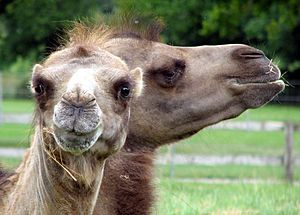
People believe Bactrian camels were first tamed around 2500 BC in what is now Afghanistan or Turkmenistan. This happened separately from the taming of the dromedary camel, which is thought to have been tamed earlier in Arabia.
As pack animals, Bactrian camels are incredibly strong. They can carry 170 to 250 kilograms (375 to 550 pounds) for 47 km (30 miles) in a day. They can also walk at 4 km/h (2 mph) for four days straight. People also ride Bactrian camels, especially in desert areas. In ancient Sindh, rich people used two-humped Bactrian camels for riding. Later, they were brought to other places like Balochistan and Iran for the same reason.
Bactrian camels have been shown in art throughout history. For example, during China's Tang Dynasty (618–907), many ceramic statues showed foreigners from places like the Tarim Basin riding camels.
Camels in the United States
Bactrian camels were brought to the US several times in the mid-to-late 1800s. The US military, merchants, and miners wanted them as pack animals because they were stronger and tougher than horses and mules. Most of these camels were eventually set free and lived in the wild. Because of this, small groups of wild Bactrian camels lived in the southwest deserts of the United States in the late 1800s.
Camels in the Military
The Indian Army uses Bactrian camels to patrol in Ladakh, a high-altitude region. They found that these two-humped camels are much better for the job than ponies. Camels can carry 170 kg (375 lbs) at heights over 17,000 feet. They can also go without water for at least 72 hours.
How Many Bactrian Camels Are There?
| Country | Population |
|---|---|
| Mongolia | 430,000 |
| China | 270,000 |
| Kazakhstan | 200,000 |
| Kyrgyzstan | 50 |
| Uzbekistan | 10,000 |
| Iran | >100 |
| Afghanistan | Unknown |
| Pakistan | 200 |
| Turkmenistan | 2,500 |
| India | 150 |
| Azerbaijan | Unknown |
| Russia | 100,000 |
| Total | >1,000,000 |
Images for kids
-
Riding a Bactrian camel in Nubra Valley, India
-
Bactrian camels in the Chuya Steppe, Altai Mountains, Russia
-
Bactrian Camel on a farm in Vermont, US
See also
 In Spanish: Camello bactriano para niños
In Spanish: Camello bactriano para niños


